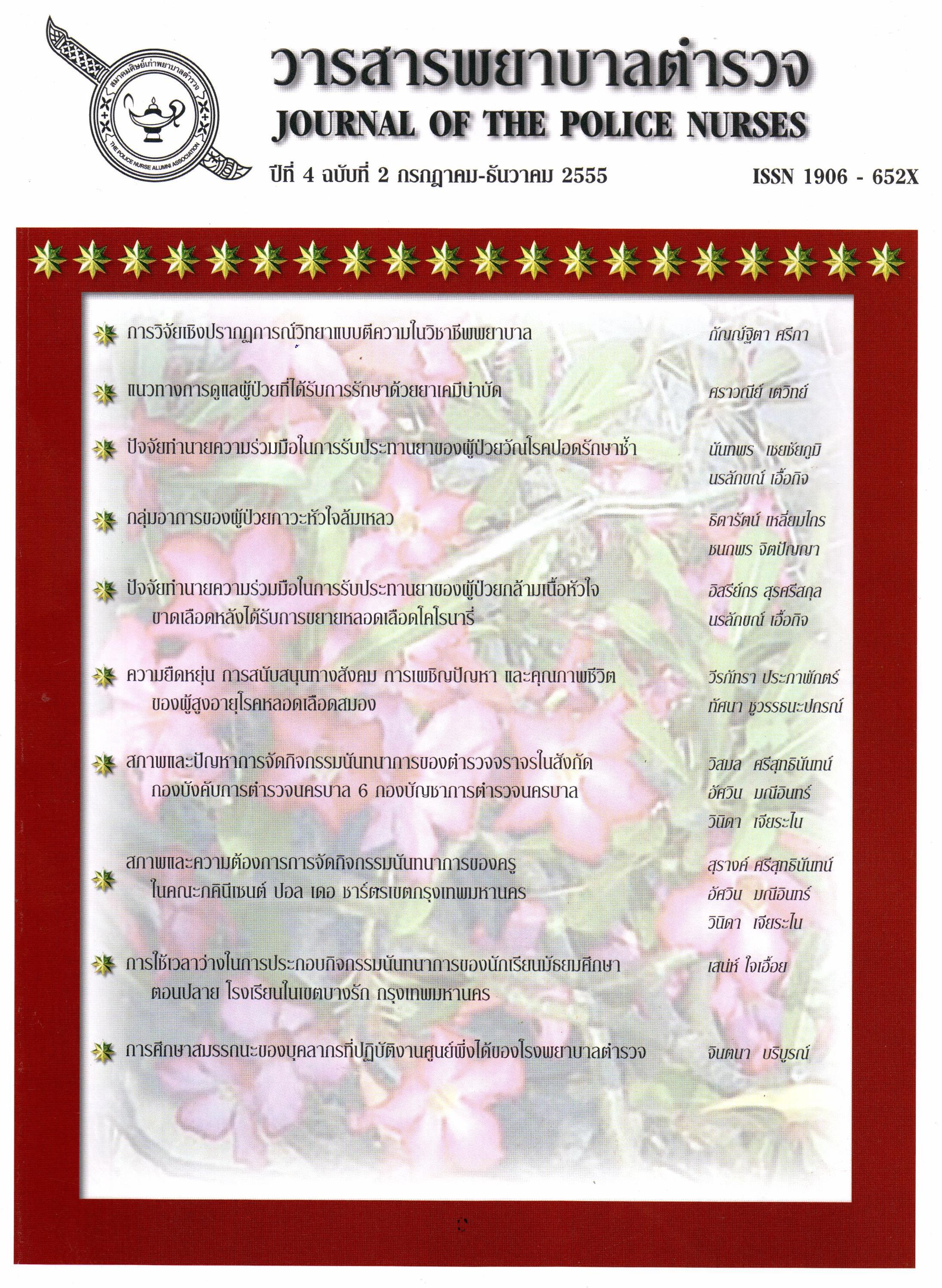กลุ่มอาการของผู้ป่วยภาวะหัวใจล้มเหลว
Keywords:
กลุ่มอาการ, หัวใจล้มเหลว, Symptom Clusters, Heart Failure PatientsAbstract
บทคัดย่อ
การวิจัยครั้งนี้เป็นการศึกษาเชิงบรรยาย มีวัตถุประสงค์เพื่อศึกษาอาการและกลุ่มอาการของผู้ป่วยที่มีภาวะหัวใจล้มเหลว กลุ่มตัวอย่างคือ ผู้ป่วยที่ได้รับการวินิจฉัยจากแพทย์ว่ามีภาวะหัวใจล้มเหลวที่เข้ารับการรักษาในหอผู้ป่วยอายุรกรรม โรงพยาบาลศูนย์ภาคใต้ จำนวน 400 คน โดยการเลือกแบบเฉพาะเจาะจง เครื่องมือที่ใช้ในการวิจัยประกอบด้วย แบบสอบถามข้อมูลส่วนบุคคล แบบประเมินอาการผู้ป่วยโรคหัวใจล้มเหลว ซึ่งผู้วิจัยพัฒนามาจากทฤษฎีอาการไม่พึงประสงค์ (Theory of Unpleasant Symptoms) ของ เลนซ และ คณะ (Lenz et al., 1997) ผ่านการตรวจสอบความตรงตามเนื้อหาโดยผู้ทรงคุณวุฒิ 5 คน และหาค่าความเที่ยงสัมประสิทธ์แอลฟาของครอนบาค ได้ค่าความเที่ยงของแบบประเมินอาการ ด้านความถี่ ด้านความรุนแรง และด้านความทุกข์ทรมานและโดยรวมเท่ากับ .86, .88, .90 และ.92 ตามลำดับ สถิติที่ใช้ในการวิเคราะห์ข้อมูลคือ การแจกแจงความถี่ ร้อยละ ค่าเฉลี่ย ส่วนเบี่ยงเบนมาตรฐาน
ผลการวิจัยพบว่า
1. ผู้ป่วยภาวะหัวใจล้มเหลวมีประสบการณ์การรับรู้การเกิดอาการมากที่สุด 5 อันดับแรก คือ แน่นหน้าอก (ร้อยละ99.25) เหนื่อยเวลานอนราบ (ร้อยละ98.50) ปัสสาวะออกน้อย (ร้อยละ98.00) อ่อนเพลีย (ร้อยละ97.75) และปวดศีรษะ (ร้อยละ97.75)
2. ผู้ป่วยภาวะหัวใจล้มเหลวรับรู้อาการในมิติด้านความถี่ของอาการทั้ง 40 รายการ มีค่าเฉลี่ยอยู่ระหว่าง 0.39-2.11 และส่วนเบี่ยงเบนมาตรฐานอยู่ระหว่าง 0.21-0.91 อาการที่มีความถี่สูงสุด ได้แก่เหนื่อยเวลานอนราบ หน้ามืดวิงเวียน แน่นหน้าอก ปัสสาวะออกน้อย และอ่อนเพลียตามลำดับ
3. ผู้ป่วยภาวะหัวใจล้มเหลวรับรู้อาการในมิติด้านความรุนแรงของอาการทั้ง 40 รายการมีค่าเฉลี่ยอยู่ระหว่าง 1.37-2.62 และส่วนเบี่ยงเบนมาตรฐานอยู่ระหว่าง 0.51-2.19 อาการที่มีความรุนแรงสูงสุด ได้แก่ เหนื่อยเวลานอนราบ ท้องโต ปวดศีรษะ ขาบวม/เท้าบวม เหนื่อยเวลาทำกิจกรรม ตามลำดับ
4. ผู้ป่วยภาวะหัวใจล้มเหลวรับรู้อาการในมิติด้านความทุกข์ทรมานของอาการทั้ง 40 รายการ มีค่าเฉลี่ยอยู่ระหว่าง 1.33- 2.67และมีส่วนเบี่ยงเบนมาตรฐานอยู่ระหว่าง 0.49-1.89 อาการที่มีความทุกข์ทรมานสูงสุด ได้แก่ ท้องโต เหนื่อยเวลานอนราบ ขาบวม/เท้าบวม ปวดศีรษะ เหนื่อยเวลาทำกิจกรรม ตามลำดับ
Symptom Clusters in Heart Failure Patients
Abstract
The purposes of this descriptive research were to study characteristics of symptoms in heart failure patients. Using purposive sampling, four hundred heart failure patients were recruited from tertiary hospitals in the southern region of Thailand. The instrument was a set of questionnaires consisting of a demographic and multidimensional symptoms questionnaire. All questionnaires were developed based on Theory of Unpleasant Symptoms Lenz et al (1997) and were validated by five experts. The Cronbach’s alpha coefficients of the instruments were .86, .88, .90 and .92, respectively. Data were analyzed using mean, percentage, and standard deviation.
The major findings were presented as follows:
1. Top five symptoms mostly experienced by heart failure patients 5 were chest pain (99.25%), orthopnea (98.50%), oligouria (98.50%), fatigue (97.75%), and headache (97.75%).
2. Symptoms experienced by heart failure patients in term of its frequency had an average score ranged from 0.39 to 2.11 (SD = 0.21- 0.91). Top five symptoms in term of its frequency were orthopnea, syncope, chest pain, oliguria, and fatigue.
3. Symptoms experienced by heart failure patients in term of its severity had an average score ranged from 1.37 to 2.62 (SD = 0.51- 2.19). Top five symptoms in term of its severity were orthopnea, abdominal distention, headache, leg swelling/ footsore, and dyspnea on exertion.
4. Symptoms experienced by heart failure patients in term of its distress had an average score ranged from 1.33 to 2.67 (SD = 0.49 -1.89). Top five symptoms in term of its distress were abdominal distention, orthopnea, leg swelling/ footsore, headache and dyspnea on exertion.
Downloads
Downloads
How to Cite
Issue
Section
License
ผลงานที่ได้ตีพิมพ์แล้วจะเป็นลิขสิทธิ์ของวารสารพยาบาลตำรวจ



